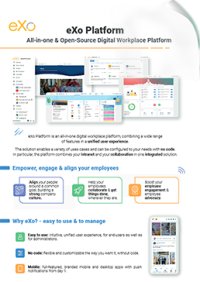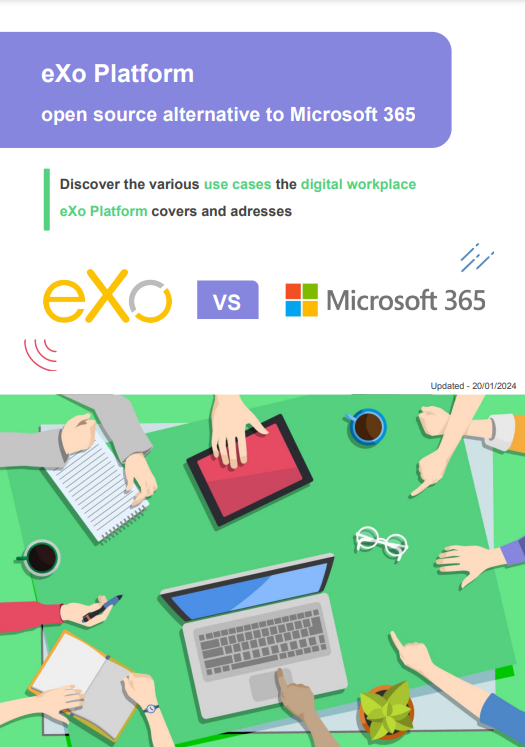

FREE DATASHEET
Download the eXo Platform Datasheet and discover all the features and benefits
For over twenty years, SharePoint On-Premise has been the foundation of many corporate intranets, an essential pillar of collaboration and document sharing. In a few months’ time, a new page will be turned.
Microsoft has officially announced the support end for SharePoint Server 2016 and SharePoint Server 2019 on July 14, 2026. From this date onwards, no security updates or technical support will be available for these on-premise versions.

This decision marks a major shift in Microsoft strategy, one that has been taking shape for several years now: pushing organizations toward the cloud, accelerating the adoption of Microsoft 365, and taking advantage of this to significantly increase the cost of licenses. This change also raises key questions for companies using SharePoint Server 2016 and 2019 solutions: what does the future hold for their data, their uses, and their past investments?
In this article, we will talk about the reasons behind this major shift for Microsoft, the challenges for organizations, and possible solutions for turning this constraint into an opportunity.
The support end for SharePoint On-Premise 2016 and 2019 is not an isolated decision: it is part of a fundamental strategy that Microsoft has been pursuing for several years.
With Microsoft 365 and SharePoint Online, the provider is focusing on a 100% cloud model, which allows it to provide continuous updates, new features, and better integration with the Microsoft ecosystem. On-premise, by definition, hinders this logic: each organization must manage its own updates, servers, patches, etc., a model that no longer fits with the “cloud first” vision.
At the beginning of the summer, Microsoft announced a significant increase in the price of on-premise licenses, in the range of 10 to 20%. Although the provider says it is opened to the possibility of setting up an on-premise SharePoint server for some customers, the objective is clear: to make maintaining your own infrastructure less and less attractive financially. For many organizations, continuing with SharePoint Server is becoming not only technically challenging, but also costly.
The support end for SharePoint On-Premise 2016 and 2019 has a direct impact on the IT strategy, budgets, security, and organization of user companies.
A tool that no longer receives updates exposes organizations to compatibility issues with their other solutions, decreased performance, and increased complexity in daily maintenance. IT teams then find themselves managing a rigid system that is costly to maintain and less suited to modern collaboration needs.
As we saw earlier, organizations wishing to update to the latest version of SharePoint on-premise will have to pay 10 to 20% more, and there is no indication that Microsoft will stop there with its price increases. Added to this are the costs associated with infrastructure (servers, hosting, energy, maintenance) and the human resources required to maintain the whole system. Ultimately, the budget equation will become untenable, especially in the face of more economical and often more modern alternatives.
While the support end for SharePoint On-Premise has technical and financial consequences, it is in the field of security that the risks become most critical. On-premise environments are often slower to apply patches and are therefore ideal targets for cyberattackers.
Last July, in the middle of the summer, a critical zero-day vulnerability was revealed on Microsoft SharePoint on-premise servers. It allowed hackers to execute code remotely without prior authentication. These attacks affected large, sometimes strategic organizations, revealing the fragility of a system that no longer benefits from real-time patches. Microsoft quickly released emergency patches for SharePoint 2019 and SharePoint Subscription Edition, but no patch was available for SharePoint 2016, leaving dozens of organizations exposed, with potentially serious consequences: leakage of personal data and possible regulatory sanctions for non-compliance with the GDPR, takeover of servers, paralysis of services, creation of invisible backdoors, etc. Not to mention a loss of trust on the part of the organization’s customers.
Furthermore, the closer the end of support date gets, the more attacks are likely to increase. Delaying your migration therefore means taking considerable risks.
Remaining tied to a proprietary platform such as SharePoint Server also means running the risk of becoming heavily dependent on a single provider: closed formats, integrations that only work with its own tools, limited customization. If Microsoft changes its licenses, pricing, or the way it interacts with other applications or solutions in the future, organizations will have no room for maneuver.
A recent example illustrates the importance of this issue: the European Commission criticized Teams’ overly tight integration with Microsoft 365, arguing that it prevented competing tools from functioning properly or being used on equal terms. Microsoft had to commit to making Teams interoperable with other applications, providing standardized APIs and protocols to make it easier to integrate competing services with Teams, and marketing the solution separately from its productivity offerings at an adjusted price.
This shows that you need to ensure that your collaborative environment (whether in the cloud or on an alternative platform) is interoperable, i.e., that it allows data exchange and is compatible with other tools, so that you don’t find yourself stuck when you want to change solutions or integrate new services.
Maintaining SharePoint on-premise also means relying on increasingly rare skills. As experts migrate to cloud environments, organizations risk running out of employees with the skills to effectively manage and secure their legacy solution.

Open Source Alternative to Microsoft 365
Empower your organization with eXo Platform to break free from Microsoft dependencies and enhance collaboration with innovative solutions
Open Source Alternative to Microsoft 365
Empower your organization with eXo Platform to break free from Microsoft dependencies and enhance collaboration with innovative solutions
The end of on-premise SharePoint may seem like an insurmountable hurdle. However, it is actually a real opportunity to rethink your digital strategy. Here are a few possible options.
This is obviously the favorite option for Microsoft. SharePoint Online provides functional continuity, integrated maintenance, and regular updates. For organizations already deeply rooted in the Microsoft ecosystem, this migration may seem natural. But it implies even greater dependence on the provider, as seen previously.
On the other hand, migrating to the Microsoft cloud means entrusting sensitive and strategic data to an American company, which raises questions of security and sovereignty. This dependence can pose compliance issues (GDPR) and, above all, exposes you to US extraterritorial laws, notably the Cloud Act, which allows judicial authorities to access data hosted by US companies on request, even if it is stored on servers based in Europe.
For public entities, strategic institutions, or companies with critical data, this loss of control represents a real risk. This is why more and more organizations are seeking to favor sovereign or open-source solutions, which guarantee better control over data.
Open-source solutions offer increased flexibility, cost control, and better data governance. They also allow you to avoid the trap of relying solely on a single cloud provider and to build a digital workplace tailored to the specific needs of your organization.
One example is eXo Platform, which provides a more comprehensive approach to collaboration than SharePoint. The open-source solution emphasizes the employee experience and data sovereignty, and can be adapted to different use cases: intranet, collaborative platform, employee portal, enterprise social network, or knowledge management. SharePoint offers a broad but locked framework, while eXo offers an open, flexible, and customizable alternative designed for organizations that want to maintain control over their digital environment.
Moving away from SharePoint On-Premise is not simply a matter of transferring data, and it cannot be done instantly. Above all, it is an opportunity to re-examine your collaboration and communication practices. Which tools are actually used by teams on a daily basis? Which processes can be simplified? What are the organization’s current needs and uses?
The end of SharePoint On-Premise can be the catalyst for a more profound transformation towards a more modern, simpler digital workplace that is better suited to the needs of employees.
July 2026 may seem far away, and you might think you still have time to consider your migration. But waiting would be a mistake. A migration of this scale requires time, method, and the right support.
The first step is to carry out a complete audit of your organization’s current setup: how are folders and documents organized and structured? Which teams use SharePoint? Which practices can be simplified or modernized? What are your employees’ needs and expectations? This mapping will help define a realistic migration plan and prioritize actions.
Transferring years of documents, data, and usage history is no small task. Anticipate the data volume, the architecture to be implemented, and governance rules to avoid losses and disorganization.
Change management is crucial in a migration project. Train your employees on the new tool, explain its concrete benefits, gather their needs, and involve them in the process to ensure the project’s success. Without support, resistance to change and disengagement will inevitably be high.
When rethinking your collaborative environment, it is essential to place cybersecurity and sovereignty at the heart of your project. Choosing an open-source solution that complies with regulatory standards and guarantees sovereignty allows you to turn this challenge into a source of trust and peace of mind.
This cannot be stressed enough! The golden rule is to start today. The earlier you anticipate, the smoother and more successful your transition will be. This time will allow you to compare existing solutions, test them, make adjustments, and gradually deploy your new platform..
For many organizations, the end of support for SharePoint On-Premise can be destabilizing: higher costs, security risks, the need to migrate large volumes of data. But it is also a real opportunity to reinvent your information system and the way you communicate and collaborate.
Now is the perfect time to reflect: how can we work together more effectively? How can we simplify the employee experience? How can we regain control over our data and costs? Even more so in today’s context, where digital sovereignty is at the center of all concerns.
July 14, 2026, may seem far away, but it’s just around the corner. Every month counts in preparing for your migration with peace of mind. What if the end of SharePoint On-Premise were the opportunity to explore open-source, sovereign alternatives like eXo Platform and set up a more modern, agile, and employee-centered work environment?
At eXo Platform, we support organizations through this transition: migration, change management, and the implementation of a complete and secure digital workplace. To learn more about our all-in-one, open-source, and sovereign digital workplace, contact us!

eXo Platform : The Open-Source
Digital Workplace Platform
Download the eXo Platform Datasheet and discover all the features and benefits


Download the eXo Platform Datasheet and discover all the features and benefits
( Your e-mail address will not be published)
I am the communication manager at eXo Platform. I found myself in communications a bit by chance, but this field brings together everything that pationates me: creativity, energy, meetings, collaborative work, sharing and exchanges of good practices. I need to give meaning to what I do and put people at the center of all my actions.